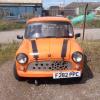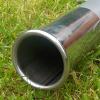Regardless of how the top arm is mounted, his point is still valid. The bottom arm is attached with a rubber bush and that will flex under load.
I don't think it's as easy to decide whether the angle of the ball joint is safe or not as you believe it is. Just because it doesn't bind on the cup doesn't mean it's not under an increased amount of stress.
Think of your knees, a pivoting joint just the same as the ball joints. Lined up as designed, you can stand up with your weight on your legs all day. Now bend your knees to say 110 degrees. Miles off the maximum travel of your leg, but you won't hold like that all day.
There is no evidence that I have seen or that anyone on this entire forum has ever said they have seen, to suggest that it will cause extra load on the ball joint, especially no proof that this extra load is enough to cause definite failure. It's all word of mouth, he said she said stuff as is always the case with the mini scene. If nobody tests it how can it be factual?
The ball joint is still doing its job no matter what angle it's rest position is.
Forget all the conjecture, and frankly you're very naive if you can't understand it:-
1) The working angle of the balljoint has a huge effect on the possibility of failure. For one thing certain is that the compressive load becomes a shear stress the more the joint is articulated. I think the analogy of a knee is pretty reasonable, going from compression loads to shear as the angle increases.
If someone has drawings of the front suspension then we can get Bow's notation and Mr Tangent out of their boxes and calculated the differences for various angles.
It's hardly necessary really, anyone with basic engineering understanding should be able to see it. Whether it breaks and how long it takes and under what circumstances are a matter for more serious investigation.
Would it be compounded more by having neg chamber aswell?




 This topic is locked
This topic is locked












